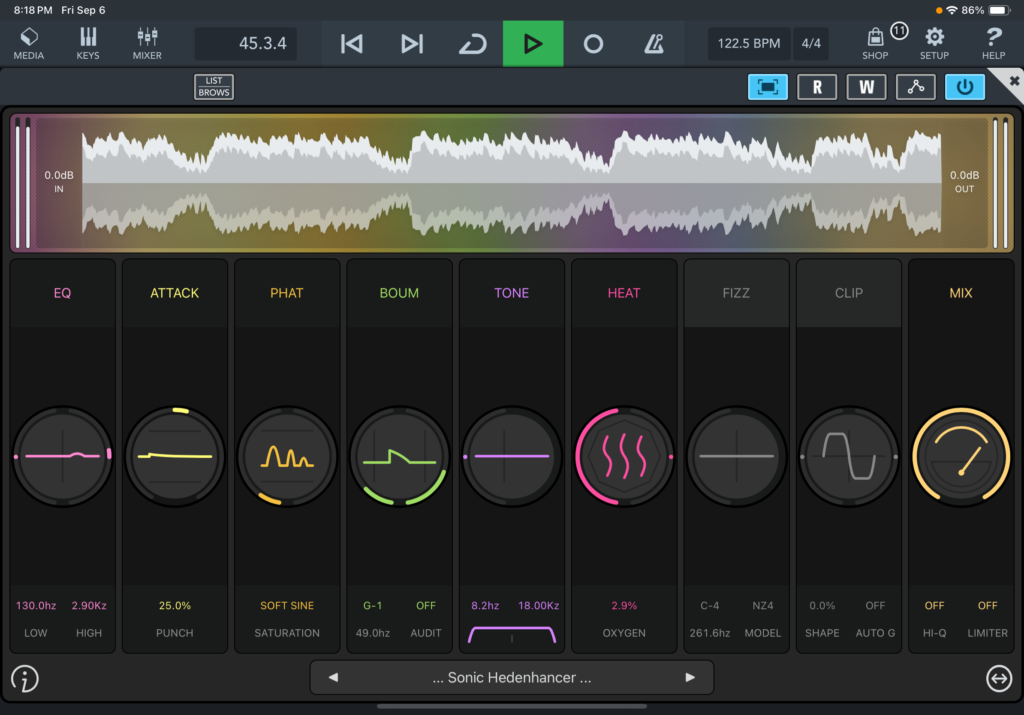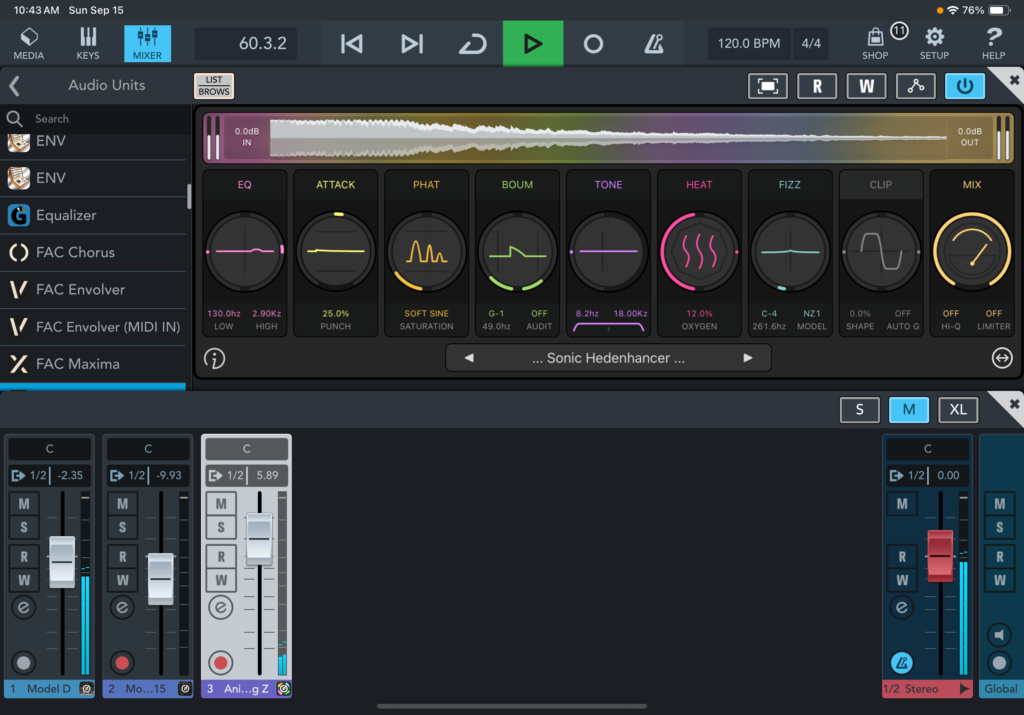Fred Anton Corvest’s iOS plugins rank among the most-used effects on our iPad music projects. Check out our review of his effects bundle from a few years ago. I primarily use Apple’s tablet computer to create beats or stems for further overdubs using Reaper on the desktop. For example, FAC Maxima remains our top plugin choice for mastering within AUM. FAC Punchlab expands this functionality and more!
Fred recently released Punchlab for iOS, a AUv3 multi-effects plugin effectively serving as a Swiss Army knife for your next music project. We decided to try it out on two stems in development for an upcoming Church of Hed album. We found FAC Punchlab to be an intuitive tool, letting you quickly dial in one or more effects for a single track, buss, or even an entire mix. Let’s check it out!
FAC Punchlab Features
- Combines up to Nine Effects on a Track or Master Buss
- Effects Provide a Full Range of Sound Design and Control
- Includes Filters, Transient Control, Limiting, Saturation, and More
- Intuitive Dynamic UI makes Touch Control a Breeze
- Responsive UI Evolves based on iPad vs. iPhone and Parent App
- Reorder Effects with Simple Gestures
- Seamless Present Management
- Supports the AUv3 Plugin Format on iOS, iPadOS, macOS, and visionOS
- Available at the App Store for $14.99
FAC Punchlab provides mobile musicians and producers with a top-shelf effects rack with a seamless, intuitive interface. Controlling the app with touch gestures especially works great on the iPad. I now use it instead of or in tandem with FAC Maxima on the master buss in AUM or Cubasis.
FAC Punchlab has a Top-Shelf iPad User Interface
The FAC Punchlab interface features an “Advanced Responsive Design,” which means it seamlessly adjusts itself based on the host app. It provides both portrait and landscape views, easily switching between the two as necessary. I used it in both AUM and Cubasis and had no problems leveraging the intuitive interface to quickly adjust effects settings.

Punchlab includes nine separate effects; simple button taps switch each effect on or off. Taps and swipes also serve to control each effect’s unique settings, including levels, switches, and other settings. An animated graphic in the middle of each effect evolves based on the changes to the settings. Simply put, the UI makes controlling Punchlab both fun and powerful.
Meters displaying the plugin’s I/O levels as well as the output waveform lie above the nine effects. Below resides the preset manager and a button displaying the app’s information screen. Note the button on the lower right that toggles a mode for reordering Punchlab’s effects. Use intuitive drag and drop gestures to move the effects around based on your desired audio flow.
Exploring the Effects of FAC Punchlab
Punchlab’s “rack of nine” provides a full range of effects suitable for instrument, buss, or master tracks. As noted earlier, simply toggle each effect on and off to get the right processing setup for your specific needs. This flexibility pays dividends on any mobile music project.

Now, let’s examine the features of each of the nine effects:
- Attack: The Attack effect lets you design transients. The Punch slider controls the attack slope, while the Depth knob manages its level, no matter the slope.
- Phat: Phat serves as the saturation effect for Punchlab. Two knobs control its drive and saturation depth. The Model button provides access to five different saturation models, providing sonic flexibility.
- Boum: A cool resonant filter, Boum offers unique sonic exploration within Punchlab. Two knobs control the depth and decay. The ability to tune the note of the resonance is also cool. Finally, the Audition switch lets you only hear the effected Boum output.
- Heat: If you need the sonic clarity provided by an exciter, Heat serves in this role for Punchlab. This effect includes control over the exciter’s amount as well as its pre-gain. Use the Oxygen slider for additional coloration and character.
- Tone: The Tone effect includes a filter array: a shelf filter plus a low-pass or high-pass option. Use the dual knob and the two sliders to control the respective cutoff frequencies.
- EQ: Another filter array with two bell filters provides EQ within Punchlab. Use the dual knob to control the gain for both, while dual sliders manage the cutoff frequencies.
- Fizz: Fizz is one of the more unique effects in Punchlab. It provides audio rate modulation using six different models, plus you also control the modulation frequency with the Note slider. Experimentation and exploration become easier when playing around with Fizz (and Boum in tandem).
- Clip: The Clip effect also provides a cool source for sonic exploration within Punchlab. You gain control over the clipper’s knee curve and gain using the knob. The Shaper slider controls the effect’s harmonic profile. The Auto-gain switch compensates for any reduction in the signal.
- Mix: Finally, the Mix control serves in its traditional role, blending the dry and wet audio signals. It also includes a High Quality switch for oversampling and a final limiter switch with brickwall, hard, and off settings.
Putting Punchlab through its Paces
As noted earlier, the iPad serves as my musical tool for beatmaking and stems. Using Punchlab in Cubasis on two stems for an upcoming Church of Hed album provided a perfect test scenario. One track includes a Berlin School synth sequence on the Minimoog Model D app with the Model 15 providing aural scenery. The other piece conjures a surreal aural landscape using the Model D in tandem with Animoog Z.
In both cases, Punchlab’s array of effects provided an easily controllable chain leveraging the app’s intuitive touch-powered user interface. Toggling effects with simple taps while controlling their parameters with finger swipes makes mobile music production alluring. Fred simply knows how to craft top-shelf user experience for iPad musicians. Note that Punchlab is also available for the iOS on the iPhone and iPod Touch, as well as the macOS and visionOS platforms. However, I only tested it on my iPad Pro.
Notably, Punchlab parameters respond to automation in Cubasis, enhancing the effects app’s capabilities for sound design or more esoteric music works. A robust preset library provides additional insights on the app’s potential uses on your next project. Access present management functionality at the bottom of the plugin.
An Essential iOS and iPadOS Effects Plugin
Punchlab quickly became one of my most essential options for different utility and creative use-cases for iPad music projects. The ease of use and intuitive interface makes learning it a breeze functionality. You need to explore adding FAC Punchlab to your effects arsenal. Fred Corvest made another great mobile music effect, or actually nine great effects in one!
